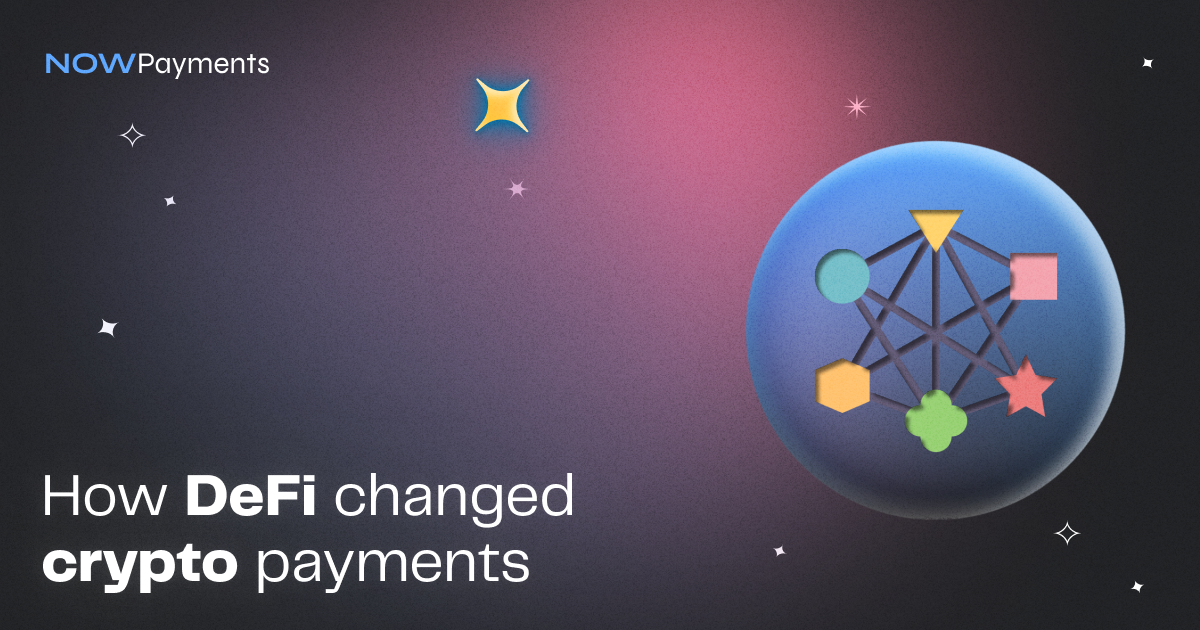The history of the DeFi industry began in December 2017, when the first decentralized autonomous organization, MakerDAO, was launched. This occurred eight years after Bitcoin‘s launch and changed the way users are able to interact with blockchain technology. So how does DeFi change the landscape of crypto payments? Let’s discuss what DeFi means, how it’s related to crypto payments, and how crypto payments are different in the DeFi world.
Key points:
- DeFi, or decentralized finance, is an umbrella term for financial products that operate on distributed ledger instead of being run by a third-party intermediary.
- DeFi is focused on applications while cryptocurrency is a store of value.
- The benefits of DeFi for crypto payment include anonymity, accessibility, transparency, and flexibility.
What is DeFi?
Decentralized finance, also known as DeFi, refers to financial services that are not run by banks or other traditional financial institutions. Anyone can access these services through decentralized applications, also referred to as dApps. They are built on blockchain networks such as Ethereum, Polygon, and Tron. DappRadar estimates that there are currently nearly 3,000 dApps with a market cap of more than $55 billion.
The DeFi segment includes lending, staking, trading, and other financial services that can be conducted directly between peers (P2P) without the use of middlemen. This is made possible by utilizing smart contracts that are at the core of blockchain technology. A smart contract is a type of Ethereum account that holds funds and sends them when pre-programmed criteria is met.
For instance, you and another user are exchanging a certain amount of Bitcoin for its equivalent in Ethereum. If one of the parties doesn’t send the funds, the contract will be automatically annulled and the other party’s funds will be returned to their wallet. If both parties do their part, the contract is executed and both get their funds. These smart contacts are public, so anyone can see, track, and audit them freely.
How DeFi and crypto payments are related
The biggest difference between DeFi and cryptocurrency is that DeFi is focused on applications while crypto is a form of digital currency. Both are working towards the same goal—decentralization. DeFi is the latest phase of blockchain technology development that makes use of distributed ledgers, smart contracts, and censorship-free financial independence.
Both DeFi and crypto payments are a part of the larger crypto infrastructure. This covers a wide range of services and products, including stablecoins, cryptocurrency tokens, wallets, exchanges, staking, lending, and insurance. Without crypto payments, most of the DeFi operations would not be possible.
How DeFi has changed crypto payments
The rising popularity of DeFi has major effects on crypto payments. Web 2.0 is where the most popular centralized crypto exchanges and wallets exist. This basically means the internet as we know it today, with websites and services that we can use in exchange for our personal data. This means creating an account, providing personal information, and even passing a verification process. Due to know your customer (KYC) and anti-money laundering (AML) regulations, proving your identity has been a prerequisite for receiving financial services.
In the meantime, Web 3.0 allows anyone who is connected to the network to use the service, so authorization is not necessary. Your access to the service cannot be blocked or denied by anyone.
These are some of the major advantages for crypto payments in DeFi:
- Open: Registering for an account is not required. You get access by simply creating a wallet.
- Anonymous: Your name, address, citizenship, nationality, or any other personal information is irrelevant and not requested to use the services. Personal data is not used for advertising purposes.
- Flexible: You have the freedom to move your assets at any time, without needing permission, without having to wait for lengthy transfers to complete, and without having to pay high fees.
- Quick: Compared to traditional centralized crypto services, interest rates and rewards are frequently updated.
- Transparent: All parties can see the full range of transactions while private businesses hardly ever allow for that level of transparency.
How can I accept crypto payments?
Benefiting from DeFi and crypto is easy with NOWPayments. NOWPayments enables instant crypto transactions with fair and transparent trading rates and fees. The service is non-custodial, so you can maintain control over your own money. Over 50 cryptocurrencies are available for payment, and you can also take advantage of automatic conversions to the currency of your choice.
To start accepting payments, register an account with an email address, verify the email address, and add the wallet address where your payments will be sent. NOWPayments tools include a point-of-sale (POS) terminal, subscriptions, mass payments, donations, and payment links.
To create a payment link, go to your account dashboard, choose Payment Tools, and open the Payment Link tab. Click the Create payment link, then select the currency and amount in the pop-up window.
You can also include an order description and an ID. Click to confirm and copy your payment permalink. It can be sent individually or pasted on your website.
Conclusion
DeFi and cryptocurrency are intertwined since both use blockchain networks to operate. Even though both markets are developing independently, it’s reasonable to anticipate that the majority of well-known crypto services, like trading, lending, and staking, will eventually move to DeFi. This will maintain and enhance the decentralized nature of cryptocurrency payments while also bringing more transparency and accessibility.

